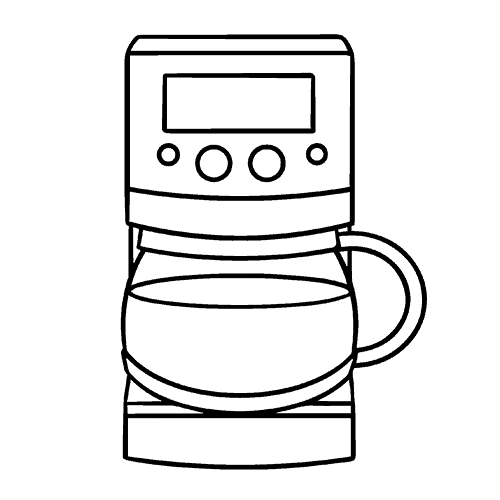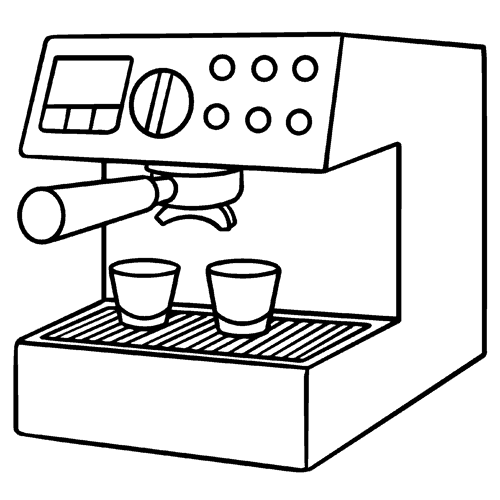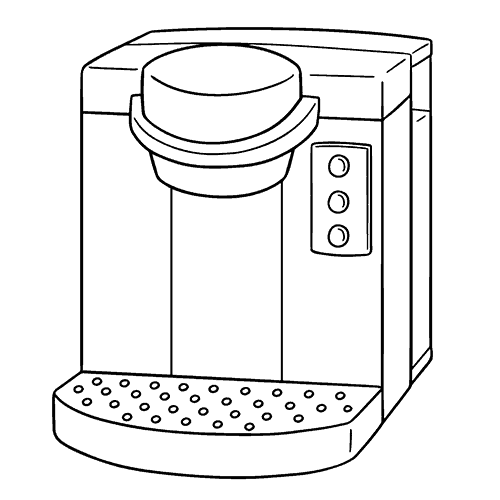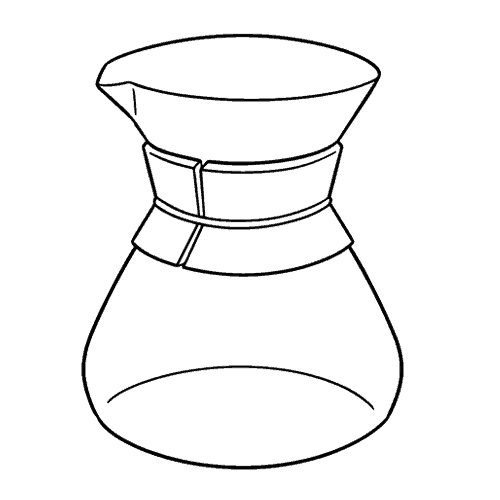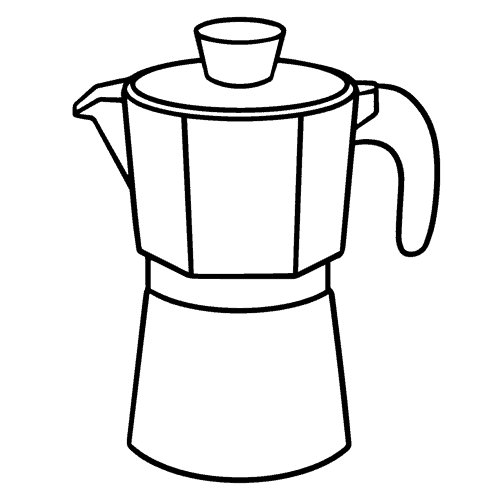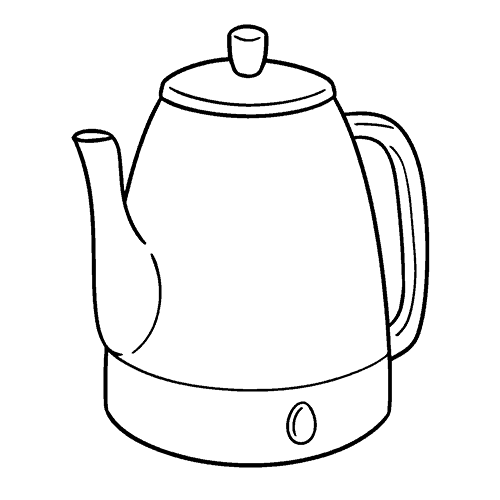Below you’ll find a quick overview of the most popular ways to brew, with links to recommendations of highly rated coffee makers in each category. One of the great things about coffee is the almost limitless variety. Hot or cold, smooth or bitter, fast or slow … the flavors, methods and presentation are individual preferences. Whether you’re new to the world of coffee, or looking to expand you coffee experience, read on to find you new favorite way to brew.
The 8 Most Popular Ways to Brew Coffee
Drip Coffee Maker
The drip coffee method has been around for a very long time and is probably the most common method used in North America. Its a simple process where heated water is poured over ground coffee beans, which are held in a filter that allows the liquid to pass through. The coffee then drips directly into a container.
Modern automatic drip coffee makers have made this process extremely convenient. You add cold water, coffee grounds, and a paper filter (depending on model). The coffee machine takes over and does the rest for you. The water is heated, sprayed over the grounds, and the coffee “drips” into a carafe ready to pour.
For more information, tips, a buyer’s checklist, and product reviews, see our Drip Coffee Makers page.
One important thing to note is the increase in convenience results in less control over the coffee making process. It is basically a one-size-fits-all solution. The same water temperature and brewing time is used for every batch of coffee. But not every bean is at its best under exactly the same brewing conditions, and some characteristics of the grounds can be lost or destroyed. Even so, depending on the model and price range, some drip coffee makers are doing very well at overcoming this limitation and producing coffee that rivals more labor-intensive brewing methods.
Is a Drip Maker for you?
- You're looking for push-button convenience and ease-of-use
- You'd like consistent results with little effort
- You want to make coffee fast and/or lots of it
- You're happy with a good basic cup of coffee
- You want to have maximum control over the coffee making process
- You’re looking to get the most out of an expensive or specialty coffee
- You want to expand your coffee making skills
French Press
The French Press (aka Press Pot) has been around since the 1920s. Today it is enjoying a resurgence in popularity because it is straightforward to operate, inexpensive and makes great coffee.
French press coffee is more dense than drip coffee but less dense than espresso. It has a medium body with rich flavor and aroma. Any roast type can be used in a french press, but medium to dark roasts work especially well. The coffee-to-water brewing ratio, as well as the size of the grounds, are key to the quality of the final brew.
For more information, tips, a buyer’s checklist, and product reviews, see our French Press page.
The simple device includes a narrow carafe, a lid, and a round close-fitting filter attached to the end of a plunger. Ground coffee is placed in the carafe, heated water is added, and is allowed to brew for approximately 4 minutes. The plunger is then gently pushed down, causing the filter to capture the coffee grounds and trap them at the bottom. Coffee is usually poured promptly, either to drink or to keep warm in another container. Leaving the coffee sit with the grounds at the bottom can cause it to become bitter, although this is a matter of taste.
Is a French Press for you?
- You like a rich, robust cup of coffee
- You're looking for a lot of control over the coffee making process
- You don't want to use waste-producing disposable products
- You want a simple, back-to-basics solution
- You need an on-the-go option
- You'd like a maker that is multi-purpose (hot brew coffee, cold brew coffee, loose tea)
- You prefer a mellower, less robust cup of coffee
- You are looking for programmable options and set-and-forget convenience
- You don't want to spend time boiling water and timing the brew.
Espresso Machine
Espresso is highly-concentrated and intense in flavor, which is why it is measured and drunk by the “shot”, a small serving commonly defined as one ounce. Because of its strength, espresso also forms the basis for several other popular coffee beverages, such as cappuccinos, lattes and macchiatos.
The defining characteristic of espresso is how it is brewed. Not-quite-boiling-hot water is forced at high pressure through finely ground coffee beans, producing a thick, strong brew.
Making espresso requires specific ingredients, tools and methods. Different types of beans can be used, depending on personal taste. But the beans must be roasted specially for this purpose. Next, they are ground to an almost powdery texture, far finer than used for regular coffee. A Burr grinder is the tool of choice to produce the consistency needed. And of course, the espresso maker itself plays a major role in the final results.
For more information, tips, a buyer’s checklist, and product reviews, see our Espresso Machine page.
Home espresso machines are broadly categorized into semi-automatic, automatic and super-automatic models. Note that these categories are not always clear, and the lines between them can be blurry. Just know that they require varying levels of user effort and offer a wide range of options and functionality.
Semi-Automatic Machines generally require you to grind the coffee, tamp it into the portafilter and place the portafilter. They give the user ability to turn the pump on and off manually, thus controlling the amount and delivery of water to the grounds.
Automatic Espresso Machines are similar to the semi-automatic versions in that they require grinding and tamping as well. You turn it on, but the machine controls the amount of water used, then shuts off automatically. These models can offer programmable options as well.
Super-Automatic Espresso Machines take convenience to the next level by doing everything from grinding the coffee, measuring out the needed amount, extracting the coffee and turning itself off. These are truly hands-off with many options and programmable settings.
Is an Espresso Machine for you?
- You want to make and serve espresso at home any time you like.
- You want to enjoy more espresso at a lower cost.
- You only drink espresso occasionally
- You don't have a dedicated space large enough for a machine to sit comfortably.
Single Serve Coffee Machine
These machines are incredibly popular because they are very fast, convenient, versatile and can create a good cup of coffee (as well as other beverages).
Single-cup coffee makers are built around the coffee pod (or capsule), a small, premeasured and sealed container of coffee designed to fit into the machine. After adding water to the reservoir and positioning the pod, simply turn on to start the cycle. The coffee maker heats water to the needed temperature and sends a precise amount through the grounds in the pod and into a waiting cup. All that’s left to do is remove the pod and dispose of it.
There is a large and every-growing selection of coffees, teas and other drinks that are available as pods. And most makers offer a refillable pod so that you can brew whatever you like.
For more information, tips, a buyer’s checklist, and product reviews, see our Single-Cup Coffee Maker page.
Two issues with single-serve coffee makers have caused concern and received a lot of publicity.
- The first concern is the possibility of mold growing inside the reservoir and ending up in your coffee. Due to the design there is always a certain amount of water left in the resevoir when not in use. And initially users were not aware that this was the case or that it could cause any problems. But now we know that simple maintenance can effectively keep the inside of the machine clean.
- The second issue is the environmental impact of the used coffee pods. Because single-serve coffee makers are so popular, discarded pods exist in mind-boggling quantities. And initially none were recyclable. This is changing though, as manufacturers are already producing more environmentally friendly products and are committed to move aggressively toward that goal. Interestingly, there is also more than one alternative options to recycle pods.
Is a Single Serve Machine for you?
- You're looking for convenience: fast, single-serving coffee with no fuss or mess
- You like the idea of a multipurpose machine (tea, coffee, cocoa, etc.)
- You enjoy drinking a wide variety of flavors and types of coffee
- You're an infrequent coffee drinker who only uses small amounts of coffee at a time
- You regularly make coffee for people with different tastes
- You need to brew in large quantities
- You're looking to get the most out of an expensive or specialty coffee
- You're concerned about potential environmental and/or health impacts of coffee pods
Pour Over Coffee Maker
Pour over makers represent the most basic method of creating coffee, yet they also offer you almost unlimited ways to personalize your brew. Hot water, manually poured over coffee grounds held in a filter, flows down through the grounds, and drips through as brew into a container below. It’s all about the coffee, the water and you.
As simple as it is, there are some accessories that make the process easier and more effective. If you want to perfect this method, you’ll need a kettle, scales, a good grinder, and perhaps filters specially designed for your maker.
For more information, tips, a buyer’s checklist, and product reviews, see our Pour Over Coffee Maker page.
One reason this method is so popular is that it gives you total control over all parts of the process: choice of beans, size of the grounds, temperature of the water, timing of the pour and the technique of the pour. Every one of these has an effect on the final product and you can fine tune to your heart’s content.
Is a Pour Over Maker for you?
- You want a simple, traditional way to brew coffee
- You want to have more control over your coffee flavor
- You are interested in a hands-on, artisanal approach
- You are looking for a relatively fast, convenient coffee making method
- You are not interested in experimenting a little to find what works for you
Moka Pot
The moka pot is a basic, uncomplicated way to create an espresso-like brew on a heat source such as a stove. Otherwise known as a ‘stovetop espresso maker’, these little pots are highly popular in areas that really care about their coffee, such as Italy and other European countries.
Although it does not create the true espresso that only comes from espresso machines, the process is very similar. The final product is close enough that many people find it their coffee of choice. So unless your taste is highly sensitive, the differences will probably seem minor.
Heated water in the bottom of the pot creates steam. The hot water is forced up through the coffee grounds, which are located in the middle of the pot. Then the brew continues to rise until it spills out into a holding area at the top of the pot. The difference from espresso is in the level of pressure reached during the brewing process and the lack of crema that is produced.
Moka pot coffee is used to make espresso-based drinks such as lattes and cappuccinos. Or it can be drunk straight, or diluted for a more typical American coffee taste.
For more information, tips, a buyer’s checklist, and product reviews, see our Moka Pot page.
Although there is not a lot of effort needed to brew using this method, it may take a bit of practice. It can produce a creamy, espresso-like coffee, but it is easy to over-extract and produce a strong brew with a slightly burnt or bitter flavor. Different people enjoy flavors all along this spectrum. A bit of trial and error should help you find a method that suits your taste.
Is a Moka Pot for you?
- You want espresso-like taste and flexibility without an espresso machine
- You prefer a simple, manual way to brew
- You would like a small, attractive pot instead of a larger machine
- You want lots of control over the process
- You're willing to go through a little trial and error to find your perfect brew
- You want consistent results without practice
- You are a coffee connoisseur who will only be satisfied with all the elements of a true espresso
Cold Brew Coffee Maker
Its easy to understand the confusion, but the truth is that cold brewed coffee is not simply hot-brewed coffee that has been refrigerated.
Cold brewing starts with a larger than usual amount of coffee grounds over which water is poured and let to sit for between 8 and 24 hours. After the desired brewing time the mixture is filtered. Depending how it was made, the resulting brew could be ready to drink or a concentrate to be diluted. The concentrate is used to create a variety of drinks by adding water, milk, cream, or ice in different amounts and combinations with other flavors.
For more information, tips, a buyer’s checklist, and product reviews, see our Cold Brew Coffee Maker page.
Brewing with slow, cold exposure obviously takes much longer than other methods. But it will reduce acidity and produce a mellower taste that is better suited to drink chilled.
Is a Cold Brew Maker for you?
- You want the flavor benefits of true cold brewed coffee.
- You like the huge variety of recipes that use cold brewed coffee.
- You drink a lot of cold coffee beverages
- You are patient enough to wait for the longer brewing times.
- You rarely drink cold coffee beverages
- You don't notice the taste difference between cold brewed and hot brewed
Percolator
Percolators have taken a hit in popularity over the decades, but they are still around, and many people still favor the strong coffee they’re known for. They continue to be in wide use by individuals and are well suited to creating large quantities of coffee for gatherings and events. The design and performance of these simple brewers continues to be improved upon.
In this brewing method, heated water in the bottom of the pot builds up pressure which forces the water into an upper chamber containing the coffee grounds. Gravity takes over and the water filters down over the grounds and drips back to the bottom of the pot. This cycle continues until the desired strength is achieved.
For more information, tips, a buyer’s checklist, and product reviews, see our Percolator page.
The repeated exposure to the grounds and the high temperature of the water can lend itself to over-extraction if not managed well. This creates a stronger and more bitter cup of coffee than a typical drip coffee maker. But many people enjoy the strong flavor and say its just a matter of practice to make great coffee with a Percolator.
Stove Top Percolators are simple, non-electric pots that sit directly on a stove or heat source. The operation and cleaning are straightforward. And though temperature regulation can be tricky depending on the heating surface you’re using, the advantage is that you have total control over temperature and brew time.
Automatic Percolators control the water temperature for you, let you know when the coffee is done, and often shift to “warm” mode to keep the coffee at a drinkable temperature.
Is a Percolator for you?
- You enjoy a strong cup of coffee
- You are looking for an inexpensive, no-frills coffee maker
- You want to make coffee while camping or in other places without electricity
- You need to make a large quantity of coffee easily and simply
- You do not enjoy the characteristic strong taste of percolated coffee
- You prefer lots of options and functionality

